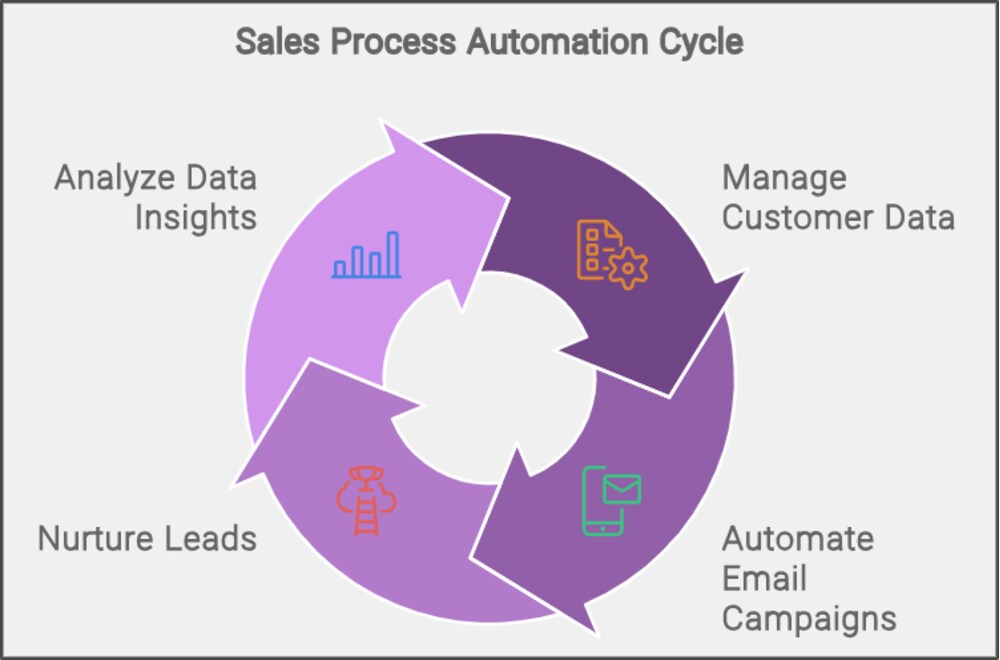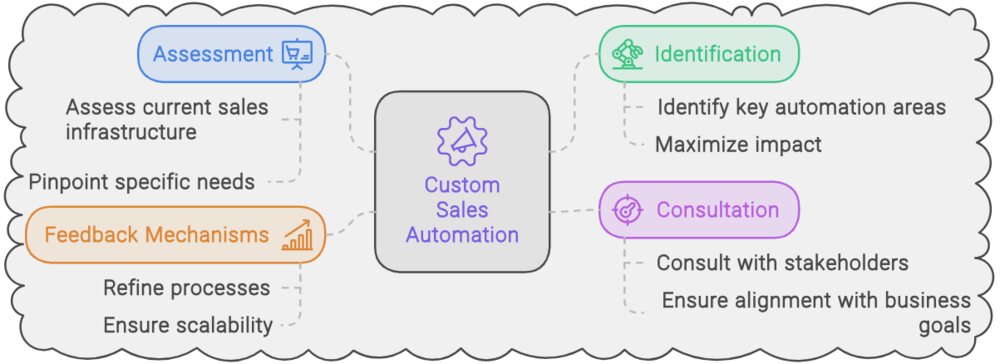How to Automate Your Sales Workflow Using Pipedrive CRM
Learn how to streamline & automate your sales workflow using Pipedrive CRM to boost efficiency and drive better result.

Discover how sales automation can streamline your processes for improved efficiency and effectiveness. Follow our guide for a smooth integration.
Today, being efficient is key to business success. Sales automation integration is changing the game. Moving from manual sales methods to dynamic, automated ones needs careful plans. Many companies are moving in this direction to make their operations more precise and scalable.
It all starts with knowing why these advanced systems matter. Then, create a smart plan that causes the least disruption and gains the most sales team buy-in. Companies understand that using a structured approach makes the change smoother. This way, they can boost their profits and stay flexible to meet market needs.
Adjusting to this new technology may be tough, from checking system compatibility to teaching teams how to use it. Yet, handling these challenges well can lead to lasting benefits and a stronger sales pipeline. Looking ahead, embracing sales automation wisely is critical. It means not just adopting new tech but doing it in a way that ensures success in the digital selling era.
Knowing how to automate sales processes is key. It helps businesses work better and smarter. Here, we explore the basics of sales automation. We look at what it is, why it matters, and how it changes the game for sales teams.
Sales cycle automation simplifies everything from first contact to closing the deal. It makes processes quicker and easier. This means sales teams can spend more time on important tasks. These include sealing deals and forging better relationships.
Another key aspect of any sales automation system is CRM automation. CRM automation ensures a touchpoint with customers feels personal. It makes the sales journey not just faster but also more responsive and thoughtful.
Essential sales automation parts include:

Automating sales processes can greatly boost efficiency. It completely changes how sales are done. View the chart to see the software’s impact, like capturing better leads.
| Feature | Impact on Sales Operations |
| Enhanced Lead Generation | Automation tools use sophisticated algorithms to identify and attract high-quality leads. |
| Improved Conversion Rates | Streamlined processes and timely follow-ups raise conversion chances. |
| Better Customer Relationship Management | CRM automation gives a full view of customer interaction with a personal touch. |
| Accurate Reporting | Data insights help with precise predictions and planning. |
Using tech like CRM automation and automated sales funnels can boost sales. These tools are now essential for success in selling things.
The journey towards making your sales top-notch starts with a close sales process evaluation. It’s about diving deep into every step of how you sell. We look for spots that might do better with new tech or ideas. This deep dive often called a sales workflow analysis, finds what’s not working smoothly. It’s the jumping-off point for making things much better.
Sales efficiency audits are key to seeing how your team works and what tools they use. These checks help figure out how complex your sales are. Then, you can tweak your selling plans to fit the actual work and the market’s needs.
This checking includes lining up what you do now against what could work better.
| Current Process | Issues Identified | Potential Improvements |
| Manual data entry and tracking | High time consumption, prone to errors | Integration of CRM systems |
| Limited follow-up on leads | Decreased conversion rates | Automated lead nurturing and follow-up sequences |
| Inconsistent sales reporting | Lack of real-time data access | Real-time analytics and dashboard implementation |
Once companies get a grip on these insights, they can polish their sales process. This boosts their sales efficiency, making customers happier and adding to their size. By always looking at and improving how they sell, businesses stay sharp in a fast-changing market.
Integrating sales automation needs a careful approach. It’s important to pick the best tools and partners. This choice will shape your sales success now and in the future.
Start by comparing sales automation tools. Look at each tool’s features. Check if they fit well with what you already use. This step avoids costly changes to your setup and ensures your work improves.
Think about costs in detail. Look not just at the software price, but also at costs for training and starting to use it. Also, consider the costs to keep it running and make it grow over time. This approach avoids surprises and helps you get the most for your money.
Choosing the right vendor is key. A good vendor offers a great product and solid support. They help integrate their solution smoothly into your existing sales setup. Finding the right partner is crucial for success.
| Feature | Compatibility | Cost (Short-term) | Cost (Long-term) | Vendor Support | Integration Ease |
| CRM Integration | High | $5,000 | $500/year | 24/7 Helpdesk | Seamless |
| Email Automation | Medium | $3,000 | $300/year | Email & Chat Support | Manual Sync Required |
| Data Analytics | Low | $7,000 | $700/year | Business Hours Support | Complex Integration |
To choose the best sales automation, look for tools that work well with your current setup. Consider both short-term and long-term costs. Choose a vendor that meets your business needs. Following these steps helps you use sales automation effectively.
Businesses aim to stay ahead by using custom sales automation. It lets them tweak their sales method to meet unique market needs through specific tools. By doing this, they not only work better but also engage their customers more effectively.

Specialized automation tools are not just new gadgets. They’re about tying new tech into what your business already does. This personalized approach helps companies understand and serve their customers better in a market that’s all about the customer.
Choosing custom sales automation brings great benefits. It makes work smoother, reduces mistakes, and earns more money. Combining tech with a personal touch is key, leading to a better customer experience and more sales.
Think about a tech company that boosted sales with a custom sales automation setup. They used a system that handled leads better and followed up faster. This approach made a big difference, showing the impact of custom sales automation done right.
Stories like this show how important it is to choose the right automation solutions. By picking what fits your business well, you’ll smoothly see big changes. This makes the step to automation worth it.
Exploring how to automate sales workflows shows it’s not just a trend. It’s key to keeping your business ahead. By using smart sales systems, firms can work more efficiently. They cut down on mistakes and let people focus on work that needs a human touch. This gives them a lead in being efficient and making more profit.
The switch to smart sales systems can be tricky. It calls for embracing new sales tools and always learning. Digital tools for sales keep improving, so staying current is a must. Putting these sales tools to work means big changes that prepare companies for the future of selling.
Automating sales is more about making a strategic choice. It’s about creating a culture that’s quick to adapt and come up with new ideas. When implemented well, these systems bring better results, happier customers, and growth. Use this article as a roadmap to bring innovation to your sales. This way, your business will lead in sales, meeting the changing needs of the market.